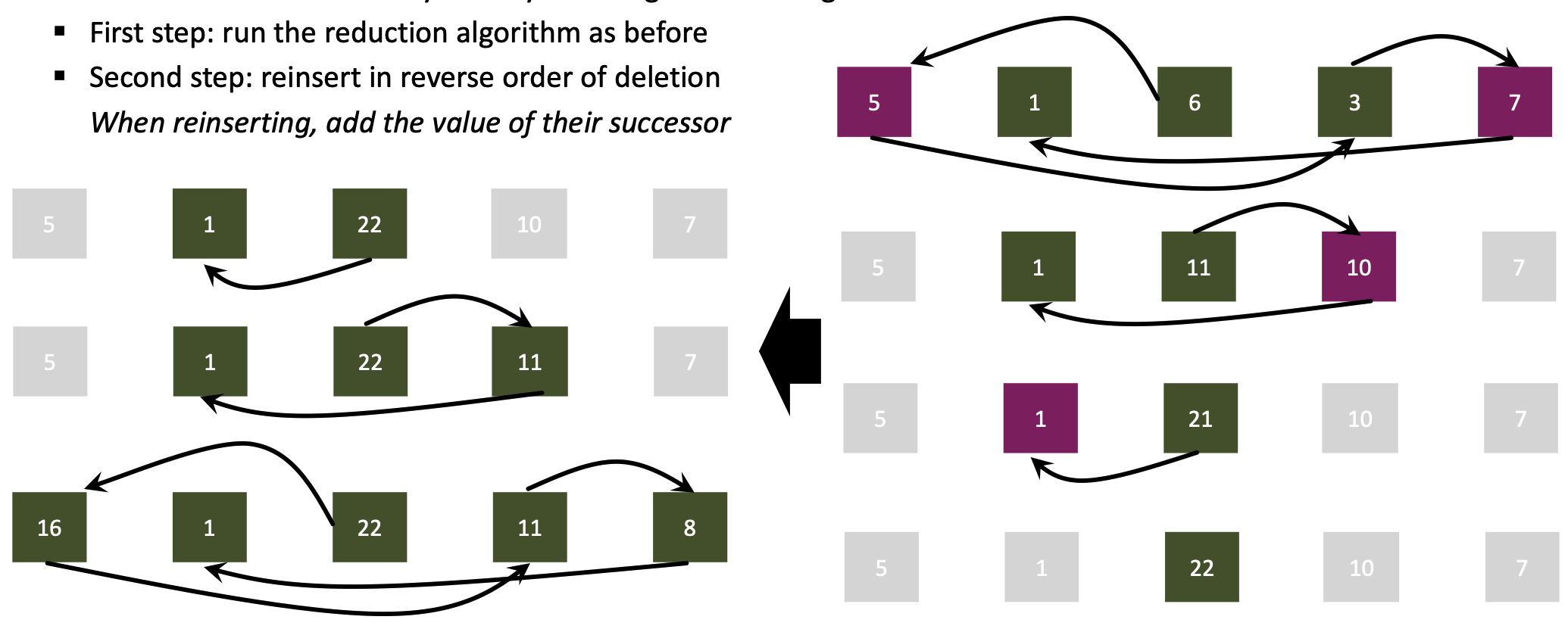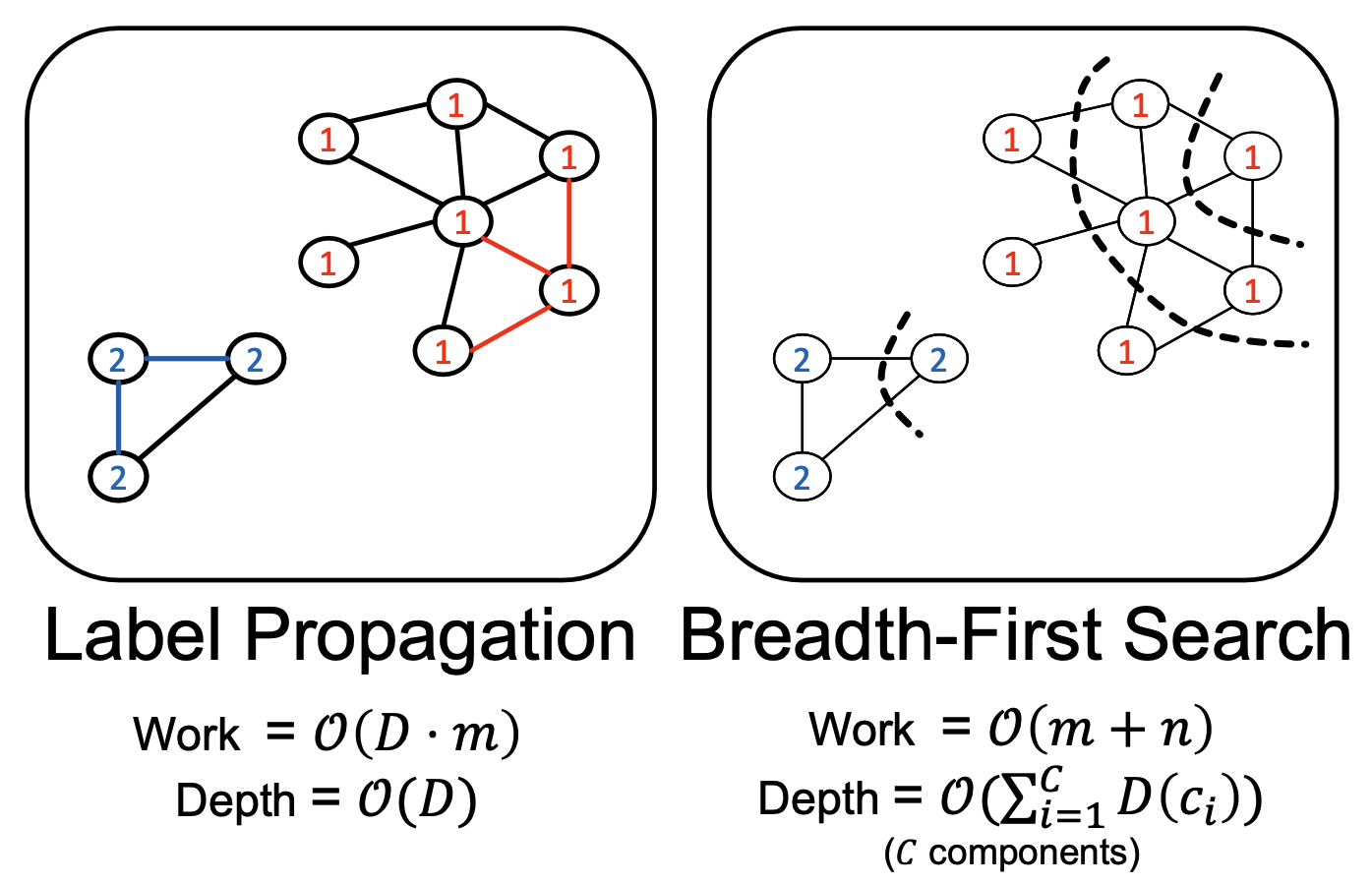Non-oblivious Algorithms
When talking about work and depth, we assume each loop iteration on a single PE is unit-cost (may contain multiple instructions!)
Given: $n$ values in linked list, looking for sum of all values 
Independent Set
A set $I ⊂ S$ is called an independent set if no $2$ elements in $I$ are connected!
Reduction on a linked list
Sequential algorithm
1
2
3
4
5
6
7
8
9
10
11
12
typedef struct elem {
struct elem *next;
int val;
} elem;
set S={all elems}
while (S != empty) {
pick some i ∈ S;
S = S - i.next;
i.val += i.next.val;
i.next = i.next.next;
}
Parallel algorithm
Basically the same algorithm, just working on independent subsets!
1
2
3
4
5
6
7
8
9
set S={all elems}
while (S != empty) {
pick independent subset I ∈ S;
for(each i ∈ I do in parallel) {
S = S - i.next;
i.val += i.next.val;
i.next = i.next.next;
}
}
Assuming picking a maximum $I$ is free, what are work and depth?
- $W = n − 1$
- $D = ⌈\log_2n⌉$
How to pick the independent set 𝑰?
- That’s now the whole trick!
- It’s simple if all linked values are consecutive in an array – same as “standard” reduction!
- There, we “compute” (know?) independent sets up-front!
Irregular linked list though?
- Idea 1: find the order of elements → requires parallel prefix sum, D’oh!
- Observation: if we pick $I > \lambda |V|$ in each iteration, we finish in logarithmic time!
Symmetry breaking:
- Assume $p$ processes work on $p$ consecutive nodes
- How to find the independent set?
- They all look the same (well, only the first and last differ, they have no left/right neighbor)
- Local decisions cannot be made
Introduce randomness to create local differences!
- Each node tosses a coin → 0 or 1
- Let $I$ be the set of nodes such that
vdrew1andv.nextdrew0!- Show that $I$ is indeed independent!
- What is the probability that $v \in I$?
Optimizations
As the set shrinks, the random selection will get less efficient
- When $p$ is close to $n ( |S| )$ then most processors will fail to make useful progress
- Switch to a different algorithm: Recursive doubling!
1
2
3
4
5
for (i=0; i <= ceil(log2n); ++i)
for(each elem do in parallel) {
elem.val += elem.next.val;
elem.next = elem.next.next;
}
Algorithm computes (reverse) prefix sum on the list!
Result:
at original list head we’ll find the overall sum.
What are work and depth?
- $W = n⌈\log_2n⌉$
- $D = ⌈\log_2n⌉$
Prefix sum on a linked list
Didn’t we just see it? Yes, but work-inefficient (if $p « n$)! We extend the randomized symmetry-breaking reduction algorithms
- Run the reduction algorithm as before
- Reinsert in reverse order of deletion
- When reinserting, add the value of their successor.
How to implement this in practice?
- Either recursion or a stack!
Nonoblivious graph algorithms - finding connected components
Connected Component
A connected component of an undirected graph is a subgraph in which any two vertices are connected by a path and no vertex in the subgraph is connected to any vertices outside the subgraph.
Each undirected graph $G = (V,E)$ contains one or multiple (at most $|V|$) connected components.
Straightforward and cheap to compute sequentially – question: how?
- Any traversal algorithm in work $O (V + E)$
- Seemingly trivial
- Becomes very interesting in parallel
- Our oblivious semiring-based algorithm was $W = O(n^3\log n), D= O(\log^2n)$
FAR from work optimality! Question: can we do better by dropping obliviousness?
- Initially, each vertex is a (singleton) supervertex
- Successively merge neighboring supervertices
- When no further merging is possible → each supervertex is a component
Shiloach/Vishkin’s algorithm
Pointer graph/forest:
- Define pointer array
PP[i]is a pointer fromito some other vertex
- We call the graph defined by
P(excluding self loops) the pointer graph - During the algorithm,
P[i]forms a forest such that- $∀i: (i, P_i)$ there exists a path from
itoP[i]in the original graph!
- $∀i: (i, P_i)$ there exists a path from
Initially, all P[i] = i. The algorithm will run until each forest is a directed star pointing at the (smallest-id) root of the component
Supervertices:
- Initially, each vertex is its own supervertex
- Supervertices induce a graph - $S_i$ and $S_j$ are connected iff $∃ u, v ∈ E$ with $u ∈ S_i$ and $v ∈ S_j$
- A supervertex is represented by its tree in P
Key components
Algorithm proceeds in two operations:
- Hook – merge connected supervertices (must be careful to not introduce cycles!)
- Shortcut – turn trees into stars
- Repeat two steps iteratively until fixpoint is reached
A fixpoint algorithm proceeds iteratively and monotonically until it reaches a final state that is not left by iterating further
Work and depth?
- $W = O (n^2\log n) , D = O(\log^2n)$ (assuming conflicts are free!)





